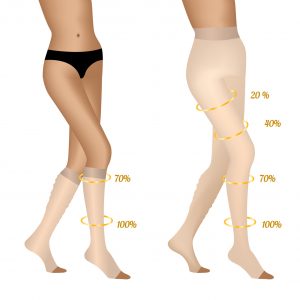Ultrasound Guided Sclerotherapy
When a larger spider vein cannot be easily seen with the naked eye, physicians will use ultrasound imaging tools to pinpoint the vein. This can happen when the veins or vein tributaries are hiding deeper in the leg. By applying a small amount of conductive gel above the area of concern, we can use a hand-held ultrasound transducer over the area. The ultrasound waves bounce back from the body’s internal structures including the veins. The result, Ultrasound Guided Sclerotherapy, is a highly detailed living picture of the veins and their functioning. The physician or physician assistant uses the image to help guide the injection of the sclerosing solution into the vein. Simply put, the ultrasound helps us ensure that the sclerosant is injected where its supposed to go.
What are the major benefits of sclerotherapy?
Sclerotherapy has been used in one form or another for over a century. New advancements, such as new compounds and ultrasounds, make modern sclerotherapy one of the most reliable treatments out there. This minimally invasive treatment uses local anesthesia, requires no downtime and is virtually painless.
Treating spider veins can improve your looks and your health so if you or someone you know is showing signs of varicose veins, do everyone a favor and call us for more information. You don’t have to live with aching, painful, swollen, or heavy legs.
Here Are Some Benefits Of Sclerotherapy In Short
- Get rid of venous problems easily
- No surgery is needed
- Small recovery period
- Excellent results
Post-treatment Restrictions
After a sclerotherapy session, we encourage our patients to wear prescription-grade compression stockings for five to seven days. They should also avoid prolonged exposure to direct sun and UV light. Strenuous exercise should be skipped for several days. But don’t worry, we’ll go over all of this with you at the time of treatment. You’ll also have some literature to take with you.
Safety of Ultrasound Guided Sclerotherapy
Very few patients ever experience complications from sclerotherapy. Some may, however, notice slight changes to skin color. What is known as post-inflammatory hyperpigmentation can take place at the injection site. Temporary bruising and soreness are also possible.
In very rare instances, a patient can develop an allergic reaction to the sclerosing compound. In extremely rare cases, the complications can lead to a serious condition such as unintentional arterial injection or deep vein blood clots. Rest assured, these happen very rarely.
Again, we will cover all possible side effects and adverse complications verbally and in writing during your consultation.
Who should and who shouldn’t go for Sclerotherapy?
While Sclerotherapy is generally considered safe and effective, it may not be suitable for everyone. Here are some guidelines on who should and who should not consider Sclerotherapy:
Who should consider Sclerotherapy?
Individuals with varicose veins or spider veins: Sclerotherapy is commonly used to treat varicose veins and spider veins, which are dilated blood vessels that can appear as visible, twisted veins on the surface of the skin. If you have varicose veins or spider veins that are causing discomfort, pain, or cosmetic concerns, Sclerotherapy may be an appropriate treatment option.
Individuals with good overall health: Sclerotherapy is generally safe for individuals who are in good overall health and do not have any underlying medical conditions that may increase the risks associated with the procedure. It’s important to disclose your complete medical history to your healthcare provider before undergoing Sclerotherapy to ensure that it is safe for you.
Individuals who are willing to follow post-treatment care instructions: Sclerotherapy requires post-treatment care, which may include wearing compression stockings, avoiding sun exposure, and avoiding certain activities for a period of time. If you are willing and able to adhere to these post-treatment care instructions, you may be a suitable candidate for Sclerotherapy.
Who should not consider Sclerotherapy?
Pregnant or breastfeeding individuals: Sclerotherapy is generally not recommended for pregnant or breastfeeding individuals, as the safety of the procedure during pregnancy or breastfeeding has not been established. Hormonal changes during pregnancy can also increase the risk of developing varicose veins or spider veins, and in many cases, these veins may improve on their own after pregnancy.
Individuals with a history of blood clotting disorders: Individuals with a history of blood clotting disorders, such as deep vein thrombosis (DVT) or pulmonary embolism, may not be suitable candidates for Sclerotherapy, as the procedure may increase the risk of blood clots forming in the treated veins.


